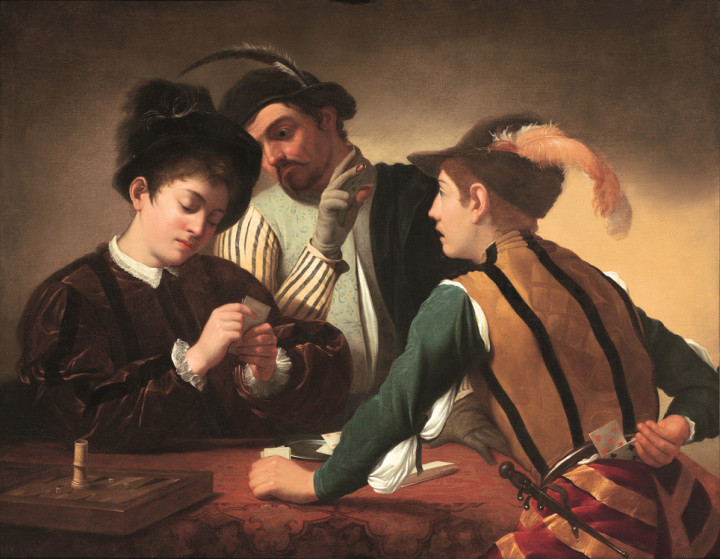Michelangelo Merisi da Caravaggio, known simply as Caravaggio, is hailed as one of the luminaries of the Baroque period. With his dramatic use of light and shadow coupled with his acute sense of realism, Caravaggio revolutionized 17th-century Italian art. Among his myriad of masterpieces, “The Cardsharps” stands out as an exemplary work, showcasing his distinct style and thematic exploration. Let’s delve into the rich tapestry of “The Cardsharps” and the genius of Caravaggio.
1. A Glimpse into “The Cardsharps”
Set against a dim backdrop, “The Cardsharps” presents a moment of cunning deception:
- The Scene: The painting captures a scene of a card game, where a young, unsuspecting player is being cheated by a cunning opponent and his accomplice.
- Characters in Play: Three figures dominate the composition—a naive aristocratic youth, a deceitful cardsharp, and a sly accomplice who subtly signals the youth’s hand.
2. Caravaggio’s Signature Chiaroscuro
One of the defining features of Caravaggio’s work is his use of chiaroscuro—a stark contrast between light and dark:
- Dramatic Illumination: In “The Cardsharps”, the figures are illuminated from the upper left, casting pronounced shadows and emphasizing the deceptive actions of the cardsharps.
- Realistic Rendering: The chiaroscuro technique lends a three-dimensionality to the characters, making them pop out against the muted background.
3. Themes and Symbolism
Beyond its visual appeal, “The Cardsharps” is rife with symbolic undertones:
- Deception and Innocence: The unsuspecting youth, with his delicate features and lavish attire, stands as a symbol of innocence and naiveté, starkly contrasting with the guile of the cardsharps.
- Moral Lessons: Many interpret the painting as a cautionary tale against the vices of gambling and deceit, serving as a moral lesson for its viewers.
4. Historical Context and Reception
“The Cardsharps” holds a special place in Caravaggio’s oeuvre:
- Early Work: Painted in the 1590s, this work is one of Caravaggio’s earlier compositions, yet it already showcases his mature style and thematic depth.
- Patronage and Popularity: The painting was commissioned by Cardinal Francesco Maria del Monte, Caravaggio’s early patron, and was widely appreciated, establishing Caravaggio’s reputation as a formidable artist.
5. Legacy of “The Cardsharps”
The influence of “The Cardsharps” extends beyond its time:
- Imitations and Homages: The painting’s popularity led to numerous imitations and reinterpretations by subsequent artists, attesting to its lasting impact.
- Caravaggio’s Influence: Works like “The Cardsharps” solidified Caravaggio’s influence on the Baroque movement, inspiring a generation of artists with his innovative techniques and thematic depth.
In Conclusion
“The Cardsharps” by Caravaggio is not just a mere representation of a scene; it is a vivid commentary on human nature, societal vices, and moral choices. Through masterful lighting, realistic portrayal, and intricate details, Caravaggio invites viewers to engage, reflect, and be mesmerized. In this painting, we witness the genius of Caravaggio—a genius that continues to captivate and inspire art enthusiasts and historians alike.
